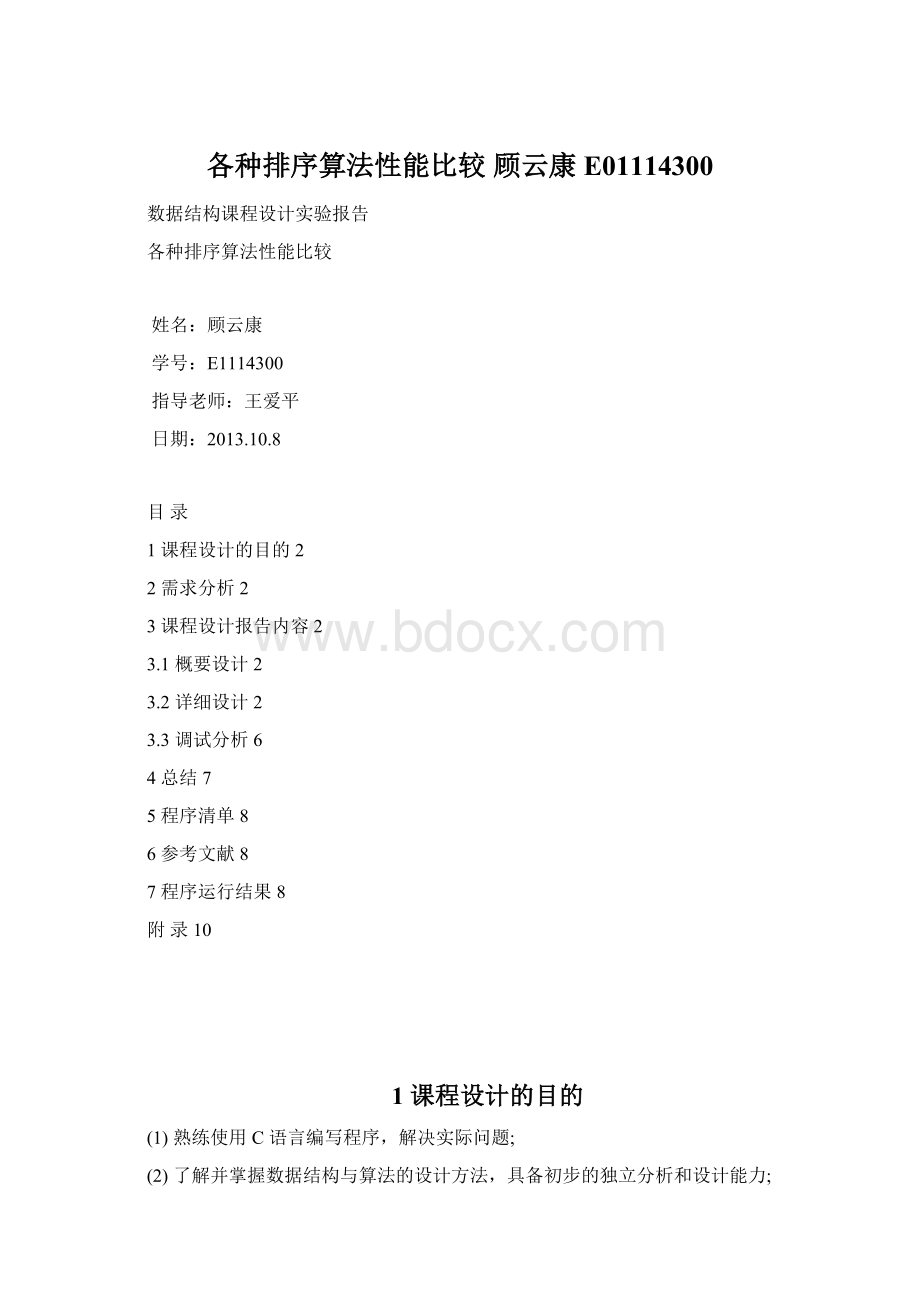各种排序算法性能比较 顾云康E01114300文档格式.docx
《各种排序算法性能比较 顾云康E01114300文档格式.docx》由会员分享,可在线阅读,更多相关《各种排序算法性能比较 顾云康E01114300文档格式.docx(15页珍藏版)》请在冰豆网上搜索。

附录10
1课程设计的目的
(1)熟练使用C语言编写程序,解决实际问题;
(2)了解并掌握数据结构与算法的设计方法,具备初步的独立分析和设计能力;
(3)初步掌握软件开发过程的问题分析、系统设计、程序编码、测试等基本方法
和技能;
(4)提高综合运用所学的理论知识和方法独立分析和解决问题的能力;
2需求分析
(1)使用数组来存放产生的40000个随机数
(2)编写统计程序运行时间的函数
(3)编写快速排序、冒泡排序、插入排序、梳排序四种排序算法的函数
(4)编写主函数,控制程序运行
3课程设计报告内容
3.1概要设计
(1)使用四种排序算法:
插入排序、冒泡排序、快速排序、梳排序
(2)使用clock()函数来统计时间
3.2详细设计
(1)主函数:
intmain()
{
intnumber[MAX]={0};
intnumber1[MAX]={0};
intnumber2[MAX]={0};
intnumber3[MAX]={0};
intnumber4[MAX]={0};
inti;
srand((unsigned)time(NULL));
/*播种子*/
for(i=0;
i<
MAX;
i++)
{
number[i]=rand()%20000;
/*产生101以内的随机整数*/
number1[i]=number2[i]=number3[i]=number4[i]=number[i];
while(number[i]==0)
{
number[i]=rand()%20000;
number1[i]=number2[i]=number3[i]=number4[i]=number[i];
}
}
//快速排序并计算时间
clock_tbegin1,end1;
doublecost1;
begin1=clock();
quicksort(number1,MAX);
end1=clock();
cost1=(double)(end1-begin1)/CLOCKS_PER_SEC;
//冒泡排序并计算时间
clock_tbegin2,end2;
doublecost2;
begin2=clock();
Bubble(number2,MAX);
end2=clock();
cost2=(double)(end2-begin2)/CLOCKS_PER_SEC;
//插入排序并计算时间
clock_tbegin3,end3;
doublecost3;
begin3=clock();
insertSort(number3,MAX);
end3=clock();
cost3=(double)(end3-begin3)/CLOCKS_PER_SEC;
//梳排序并计算时间
clock_tbegin4,end4;
doublecost4;
begin4=clock();
combsort(number4,MAX);
end4=clock();
cost4=(double)(end4-begin4)/CLOCKS_PER_SEC;
for(intj=0;
j<
MAX;
j++)
printf("
%d"
number1[j]);
printf("
\n"
);
排序完成!
快速排序耗时:
%lfseconds\n"
cost1);
冒泡排序耗时:
cost2);
插入排序耗时:
cost3);
梳排序耗时:
cost4);
return0;
}
(2)插入排序函数:
voidinsertSort(inta[],intlen)
inti,j,temp;
for(i=1;
len;
i++)
temp=a[i];
for(j=i-1;
j>
=0;
j--)
if(a[j]>
temp)
{
a[j+1]=a[j];
}else
break;
}
a[j+1]=temp;
(3)冒泡排序函数:
voidBubble(inta[],intlen)
intlength=len;
inti=0;
intj=0;
for(;
i<
len;
i++)
for(;
length;
if(a[j]>
a[j+1])
inttemp=a[j];
a[j]=a[j+1];
a[j+1]=temp;
length--;
j=0;
(4)快速排序函数:
intpartions(intl[],intlow,inthigh)
intprvotkey=l[low];
l[0]=l[low];
while(low<
high)
while(low<
high&
&
l[high]>
=prvotkey)
--high;
l[low]=l[high];
l[low]<
=prvotkey)
++low;
l[high]=l[low];
l[low]=l[0];
returnlow;
voidqsort(intl[],intlow,inthigh)
intprvotloc;
if(low<
prvotloc=partions(l,low,high);
//将第一次排序的结果作为枢轴
qsort(l,low,prvotloc-1);
//递归调用排序由low到prvotloc-1
qsort(l,prvotloc+1,high);
//递归调用排序由prvotloc+1到high
voidquicksort(intl[],intn)
qsort(l,1,n);
//第一个作为枢轴,从第一个排到第n个
(5)梳排序函数:
voidcombsort(inta[],intn)
floatshrink_factor=1.3;
intgap=n,swapped=1,swap,i;
while((gap>
1)||swapped)
if(gap>
1)gap=gap/shrink_factor;
swapped=0;
i=0;
while((gap+i)<
n)
if(a[i]-a[i+gap]>
0)
swap=a[i];
a[i]=a[i+gap];
a[i+gap]=swap;
swapped=1;
++i;
3.3调试分析
(1)使用随机数产生函数,产生40000个随机数,再使用四种算法进行排序,并统计各种算法统计时间。
(2)运行截图如下:
(3)由多次试验结果可得,梳排序和快速排序的排序速度相对较快。
4总结
通过这次课程设计我认识到了排序功能在解决实际问题中的作用,使我对数据结构的学习有了更进一步的理解。
在完成本次课程设计中,我发现很多理论性知识在实际使用时与单纯的理论还是有所差别的,今后我会更加注重培养自己的实践动手能力。
5程序清单
见附录
6参考文献
[1]严蔚敏,吴伟民编著.数据结构(C语言版)--北京:
清华大学出版社,2007.
[2]严蔚敏,吴伟民米宁编著.数据结构题集(C语言版)--北京:
[3]http:
//zh.wikipedia.org/wiki/%E6%A2%B3%E6%8E%92%E5%BA%8F
7程序运行结果
附录
程序清单:
#include"
stdafx.h"
#include<
stdio.h>
stdlib.h>
time.h>
/*用到了time函数,所以要有这个头文件*/
#defineMAX40000
//插入排序
//冒泡排序
//快速排序